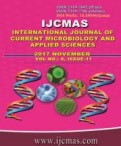


 National Academy of Agricultural Sciences (NAAS)
National Academy of Agricultural Sciences (NAAS)

|
PRINT ISSN : 2319-7692
Online ISSN : 2319-7706 Issues : 12 per year Publisher : Excellent Publishers Email : editorijcmas@gmail.com / submit@ijcmas.com Editor-in-chief: Dr.M.Prakash Index Copernicus ICV 2018: 95.39 NAAS RATING 2020: 5.38 |
Oleaginous mould Mucor rouxii was cultivated in the medium containing glucose, starch and cellulose with an initial C/N ratio of 60. The biochemical behaviors of Mucor rouxii were examined: The highest lipid yield (4.9 g/L) was found with glucose as the carbon substrate. Starch was good for biomass production (15.5 g biomass/L medium). The Lipid content in biomass with starch as the carbon substrate was less than glucose (25%). The maximum lipid yield was increased (up to 5.8 g/L) with increasing the starch concentration to 60 g/L. Cellulose did not support lipid production. Significant quantities of α-amylase (0.5 and 1.2 IU/mL) and cellulase (0.19 IU/mL) were produced. The research suggest that in order to consume complex carbon substrates oleaginous mold should secrete complex enzymes to break down the substrates into simpler sugars and channelize them for lipid production. This study is one of the first in utilizing cellulose as a carbon source for lipid and Gamma Linoleic Acid (GLA) accumulation. The content of GLA varied considerably with the substrates.
 |
 |
 |
 |
 |